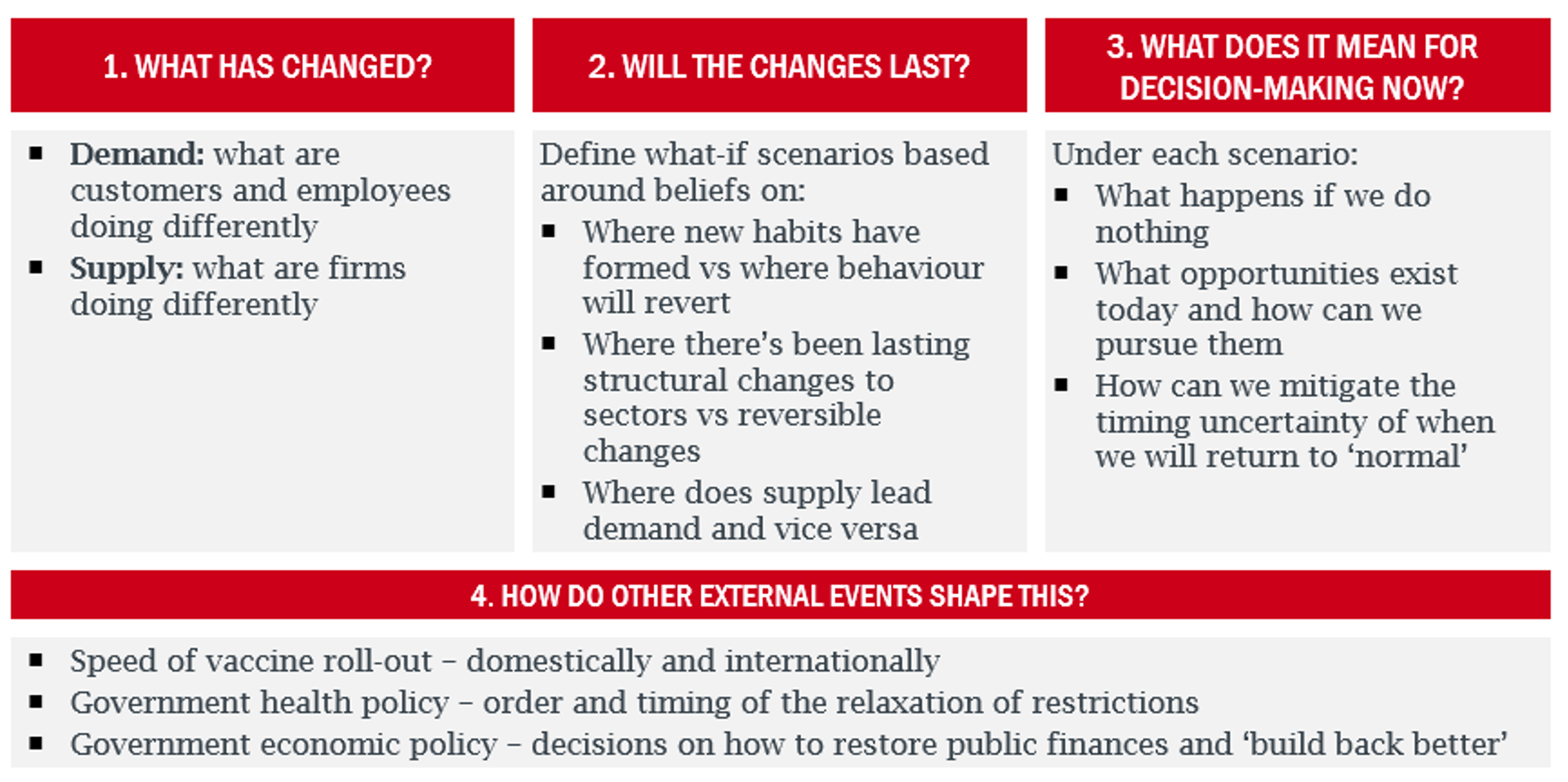A year ago, the world was in shock over the emergence of a fast-spreading, deadly new coronavirus. Fast forward to today and there’s light at the end of the tunnel: vaccines against COVID-19 have been developed in record time and are being rolled out. But it remains unclear how long it will take to emerge, blinking, from the dark and what life will look like once we do. Businesses need to build this uncertainty into their planning. What habits have changed permanently as a result of the pandemic? Is working from home here to stay? Will consumers flock back to the supermarkets or stick with online shopping? We still think the best way of navigating the uncertainty is to be clear about the changes both to demand and supply. A five-question framework that we drew up a year ago, and which we have now updated, is designed to do just that.
Businesses try to plan for post-pandemic life
The past year was one of huge change and uncertainty. What started as news reports of an unknown virus developed into the biggest shock that most of us have faced in our lifetimes, with large swathes of the global economy ordered to shut down and billions of people confined to their homes. Governments responded with some of the largest interventions seen in peacetime.
Some countries dealt effectively with the initial onslaught of COVID-19, fanning optimism that the disease would be swiftly brought under control. These early hopes were understandable, but business plans built on a return in time for summer, Halloween, Black Friday or Christmas were dashed when second (and third) waves of the virus crashed over most Western economies.
One year on, optimism is back – and more solidly grounded. Successful vaccines, developed at breakneck speed, allow us to chart a course out of lockdown and a return to something like normal. But uncertainty remains as to how long it will take fully to overcome the crisis and what life after COVID-19 will look like.
- For customers, the pandemic has prompted huge changes in behaviour. The key question is how sticky these changes will prove to be. Without doubt we will return to cafes, restaurants and cinemas once restrictions are relaxed; concerts and overseas travel will resume. The leisure, hospitality and travel sectors, then, will re-emerge, albeit in a different state (see next section). But what about all those changes in consumer behaviour that were already well underway and have been supercharged in the past year? Will we continue with online shopping, home-working, distance-learning and the use of contactless payments? How will habits vary among different segments of the population, and what does that mean for businesses serving these groups?
- For businesses selling to consumers, there have been winners and losers. Some have had no choice but to innovate rapidly, often capital light, to sustain cashflows. Retailers have scaled up their online operations through doorstep delivery and click-and-collect; food-to-go chains have pivoted to target people working from home; restaurants have launched new meal kits and delivery options; wholesale suppliers have developed direct-to-consumer channels; and service providers, from personal trainers to therapists, have migrated to video. In doing so, businesses will have seen changes in their customer base – bringing in new customers, and helping to shape new behaviours in their existing base. Will those that have made it through stay with their more varied proposition or simply go back to how they operated before? As for the losers, failures in a number of sectors, notably high-street fashion and department stores, have prompted more substantial restructuring, as other businesses (sometimes competitors with deeper pockets and better suited business models) identify and invest in new growth opportunities, including through M&A. The upshot is that some parts of the economy are being reshaped in ways that will outlast the pandemic.
So how should businesses plan for 2021 and beyond in the face of this continued uncertainty?
We stand by what we wrote last year: the best place to start is with a really clear, factual view of what has changed – both for customers (the demand side) and competitors (the supply side). Then use this as the basis to explore what-if scenarios of how these changes may play out over the coming years, the implications for decision-making today and what impact external factors (most notably government policy) may have. Our framework, slightly adapted from the one we used a year ago, sets out this approach:

Understanding change has always been at the core of good business planning - even before the wrenching shifts we are living through now. Working on these questions with our clients over the last 12 months has helped make sense of the speed and scale of change. But in adopting this approach we believe the aim should really be to outlive the current disruption. If there are positives to emerge from this pandemic, a stronger focus on behaviours, changing data and flexible business planning should be among them.
Keep monitoring our website for updates as we go through this framework and offer answers to these questions.




